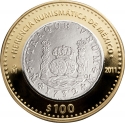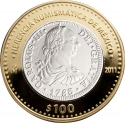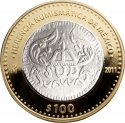You are about to finish your registration. Please check your mailbox (including spam folder). There should be a letter with a confirmation link. Check setting to make sure that your e-mail address is correct.
Send letter againDescription
In 2011, the Mexican Mint started a four year series featuring 24 classic coins of Mexico. This fine collection of Bi-Metallic Silver (0.925) coins represents about five centuries of the numismatic heritage of Mexico which includes famous coins ranging from the first coins minted by la Casa de Moneda de México, the Mexican Mint, during the XVI century, to contemporary XX century mints. The collection not only offers insight into the evolution of the Mexican coin, but is also a window on Mexican history and art, besides fostering coin collecting and numismatics.
Obverse

|
Depicts the seal of the United Mexican States. ESTADO UNIDOS MEXICANOS |
|---|---|
Reverse

|
At the center, the image of the obverse of a colonial Mexico coin, 8 Reales 1811 (KM# 190), struck in Zacatecas, Provisional Royalist; at the upper side, parallel to the coin frame, the legend NUMISMATIC HERITAGE OF MEXICO; on the left side, the Mexican mint mark, while on the right field is the $100. HERENCIA NUMISMATICA DE MEXICO |
| Edge |
100 Pesos
Numismatic Heritage of Mexico
Ferdinand VII Provisional Royalist 8 Reales
Subscribe series
KM# 965
Numismatic Heritage of Mexico
Ferdinand VII Provisional Royalist 8 Reales
Characteristics
| Type | Commemorative Issue (Non-circulating) |
| Material | Bi-Metallic |
| Ring | Aluminium Bronze |
| Center | Silver |
| Weight | 33.97 g |
| Diameter | 39 mm |
| Thickness | 4 mm |
| Shape |
|
| Alignment | Coin |
| Mint |
Mexican Mint (Mo)
|









